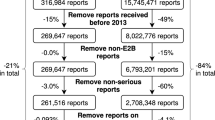Abstract
A study was conducted to explore the potential difference in geographic and cross-cultural variation in safety adverse drug reaction reporting. Attempts were made in the study design to minimize genetic differences, market representation, age, and gender as confounding factors in affecting the findings. Six thousand spontaneous reports from five countries (France, Germany, United Kingdom, United States, and Canada) were randomly generated from our spontaneous safety database which covered a 15-year reporting period (March 1, 1983 to December 31, 1997). The reports were then reviewed and compared against each country for several factors of interest. Despite some limitations, there are interesting observations from the current study that are worth further review. For example, German reports seem more likely to be serious, related to death and life-threatening events, and may warrant more attention. The Canadian and American reports had the highest numbers in the category of lack of drug effect. When further analyzed using continent rather than country as a base, Europe was consistently higher in terms of number of serious reports, death/life-threatening events, and cases of overdose. The current study is limited to our experience and further research by other investigators to confirm these findings is warranted.
Similar content being viewed by others
References
Johnson JM, Tanner LA. Postmarketing surveil-lance: curriculum for the clinical pharmacologist. Part [[: Clinical and regulatory considerations. J Clin Pharmacol. 1993;33:1015–1022.
Piazza-Hepp TD, Kennedy DL. Reporting of ad-verse events to MedWatch. Am J Health-System Pharm. 1995;52:1436–1439.
Rossi AC, Knapp DE. Discovery of new adverse drug reactions: a review of the Hood and Drug Administration’s spontaneous reporting system. JAMA. 1984;252:1030–1033.
Sills JM, Tanner JA, Milstien JM. Food and Drug Administration monitoring of adverse drug reactions. Am J Hosp Pharm. 1986;43:2764–2770.
Strom BL, Melmon KL. Can postmarketing surveillance help to effect optimal drug therapy? JAMA. 1979;242:2420–2423.
Lortie FM. Postmarketing surveillance of adverse drug reactions: problems and solutions. Canadian Med Assoc J. 1986;135:27–32.
Moore N, Biour M, Paux G, et al. Adverse drug reaction monitoring: doing it the French way. Lancet. 1985;2:1056–1058.
Litovitz T. The TESS database. Use in product safety assessment. Drug Safety. 1998;18:9–19.
Finney DJ. The detection of adverse reactions to therapeutic drugs. Stat Med. 1982;1:153–161.
Rossi AC, Bosco L, Faich GA, Tanner LA. The importance of adverse reaction reporting by physicians. JAMA. 1988;259:1203–1204.
Clark JA. Zimmerman HJ, Tanner LA. Labetalol hepatotoxicity. Ann Intern Med. 1990;113:210–213.
Green L, Clark J. Fluoroquinolones and theophylline toxicity: Norfloxacin. JAMA. 1989:262:2383.
Jolson H, Tanner LA, Green L. Adverse reaction reporting of interactions between warfarin and fluoroquinolones. Arch Intern Med. 1991;151:1003–1004.
Belton KJ. Attitude survey of adverse drug-reaction reporting by health care professionals across the European Union. The European Pharmacovigilance Research Group. European J Clin Pharmacol. 1997;52:423–427.
Cosentino M, Leoni O, Banfi F, Lecchini S, Frigo G. Attitudes to adverse drug reaction reporting by medical practitioners in a Northern Italian district. Pharmacolog Res. 1997;35:85–88.
Bateman DN, Sanders GL, Rawlins MD. Attitudes to adverse drug reaction reporting in the Northern Region. Br J Clin Pharmacol. 1992;34:421–426.
Generali JA, Danish MA, Rosenbaum SE. Knowledge of and attitudes about adverse drug reaction reporting among Rhode Island pharmacists. Ann Pharmacother. 1995;29:365–369.
Brenner MH. Economic change, alcohol consumption and heart disease mortality in nine industrialized countries. Soc Sci Med. 1987;25:119–132.
Griffin JP. Survey of the spontaneous adverse drug reaction reporting schemes in fifteen countries. Br J Clin Pharmac. 1986;22(supplement):83S–100S.
Melnychuk D, Monde Y, Abenhaim L. Monitoring of drug utilization in public health surveillance activities: a conceptual framework. Can J Public Health. (Revue Canadienne de Sante Publique) 1993;84:45–49.
Albengres E. Features of the French postmarketing drug surveillance system. Application to cutaneous effects of nonsteroidal antiinflammatory drugs. J Rheumatol. 1988;17(supplement):20–23.
Albengres E, Gauthier F, Tillement JP. Current French system of post-marketing drug surveillance. Int J Clin Pharmacol, Therapy, Toxicol. 1990;28:312–314.
Kapp JF, Zentgraf R, Widmer A, Schopf E. A need to intensify drug surveillance in Germany. Klinische Wochenschrift. 1991;69:775–779.
Bern JL, Breckeridge AM, Mann Rd, Rawlins MD. Review of yellow cards (1986): report to the committee on the safety of medicines. Br J Clin Pharmac. 1988;26:679–689.
Smith CC, Bennett PM, Pearce Hm, et al. Adverse drug reactions in a hospital general medical unit meriting notification to the Committee on Safety of Medicines. Br J Clin Pharmacol. 1996;42:423–429.
van Boxtel CJ, Wang G. Some observations on pharmacoepidemiology in Europe. Netherlands J Med. 1997;51:205–212.
Richard BW, Lasagna L. Drug regulation in the United States and the United Kingdom: the Depo-Provera story. Ann Int Med. 1987;106:886–891.
Baum C, Kennedy DL, Forbes MB, Jones JK. Drug use in the United States in 1981. JAMA. 1984;251:1293–1297.
Raehl CL, Bond CA, Pitterle ME. Pharmaceutical services in U.S. hospitals in 1989. Am J Hosp Pharm. 1992;49:323–346.
O’Neil CK, Poirer TI. Impact of patient knowledge, patient-pharmacist relationship, and drug perceptions on adverse drug therapy outcomes. Pharmacother. 1998;18:333–340.
Poulton BC. Use of the consultation satisfaction questionnaire to examine patients’ satisfaction with general practitioners and community nurses: reliability, replicability and disciminant validity. Br J General Practice. 1996;46:26–31.
Author information
Authors and Affiliations
Corresponding author
Rights and permissions
About this article
Cite this article
Wu, HH., Fung, M., Hornbuckle, K. et al. Impact of Geographic and Cross-Cultural Differences on Spontaneous Adverse Events Reporting. Ther Innov Regul Sci 33, 921–931 (1999). https://doi.org/10.1177/009286159903300333
Published:
Issue Date:
DOI: https://doi.org/10.1177/009286159903300333




